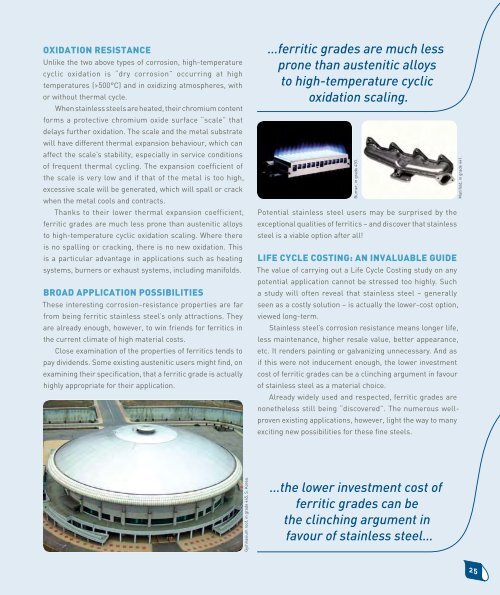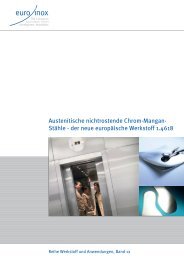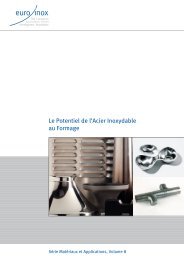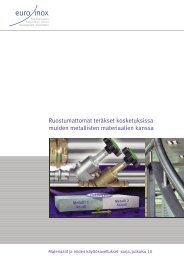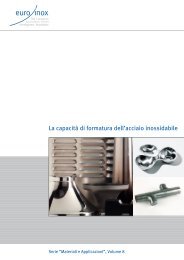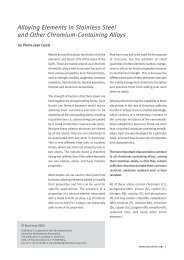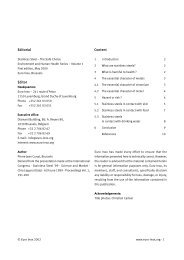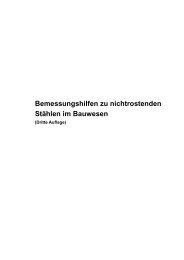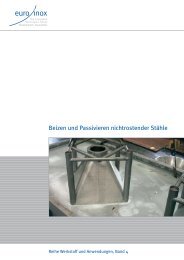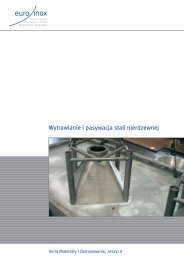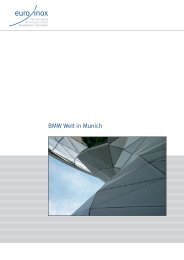The Ferritic Solution - Euro Inox
The Ferritic Solution - Euro Inox
The Ferritic Solution - Euro Inox
Create successful ePaper yourself
Turn your PDF publications into a flip-book with our unique Google optimized e-Paper software.
oxidation ReSiStance<br />
unlike the two above types of corrosion, high-temperature<br />
cyclic oxidation is “dry corrosion” occurring at high<br />
temperatures (>500°c) and in oxidizing atmospheres, with<br />
or without thermal cycle.<br />
when stainless steels are heated, their chromium content<br />
forms a protective chromium oxide surface “scale” that<br />
delays further oxidation. the scale and the metal substrate<br />
will have different thermal expansion behaviour, which can<br />
affect the scale’s stability, especially in service conditions<br />
of frequent thermal cycling. the expansion coefficient of<br />
the scale is very low and if that of the metal is too high,<br />
excessive scale will be generated, which will spall or crack<br />
when the metal cools and contracts.<br />
thanks to their lower thermal expansion coefficient,<br />
ferritic grades are much less prone than austenitic alloys<br />
to high-temperature cyclic oxidation scaling. where there<br />
is no spalling or cracking, there is no new oxidation. this<br />
is a particular advantage in applications such as heating<br />
systems, burners or exhaust systems, including manifolds.<br />
bRoad appLication poSSibiLitieS<br />
these interesting corrosion-resistance properties are far<br />
from being ferritic stainless steel’s only attractions. they<br />
are already enough, however, to win friends for ferritics in<br />
the current climate of high material costs.<br />
close examination of the properties of ferritics tends to<br />
pay dividends. Some existing austenitic users might find, on<br />
examining their specification, that a ferritic grade is actually<br />
highly appropriate for their application.<br />
Gymnasium roof, in grade 445, S. Korea.<br />
…ferritic grades are much less<br />
prone than austenitic alloys<br />
to high-temperature cyclic<br />
oxidation scaling.<br />
potential stainless steel users may be surprised by the<br />
exceptional qualities of ferritics – and discover that stainless<br />
steel is a viable option after all!<br />
Life cycLe coStinG: an invaLuabLe Guide<br />
the value of carrying out a life cycle costing study on any<br />
potential application cannot be stressed too highly. Such<br />
a study will often reveal that stainless steel – generally<br />
seen as a costly solution – is actually the lower-cost option,<br />
viewed long-term.<br />
Stainless steel’s corrosion resistance means longer life,<br />
less maintenance, higher resale value, better appearance,<br />
etc. it renders painting or galvanizing unnecessary. and as<br />
if this were not inducement enough, the lower investment<br />
cost of ferritic grades can be a clinching argument in favour<br />
of stainless steel as a material choice.<br />
already widely used and respected, ferritic grades are<br />
nonetheless still being “discovered”. the numerous well-<br />
proven existing applications, however, light the way to many<br />
exciting new possibilities for these fine steels.<br />
Burner, in grade 430.<br />
…the lower investment cost of<br />
ferritic grades can be<br />
the clinching argument in<br />
favour of stainless steel…<br />
Manifold, in grade 441.


